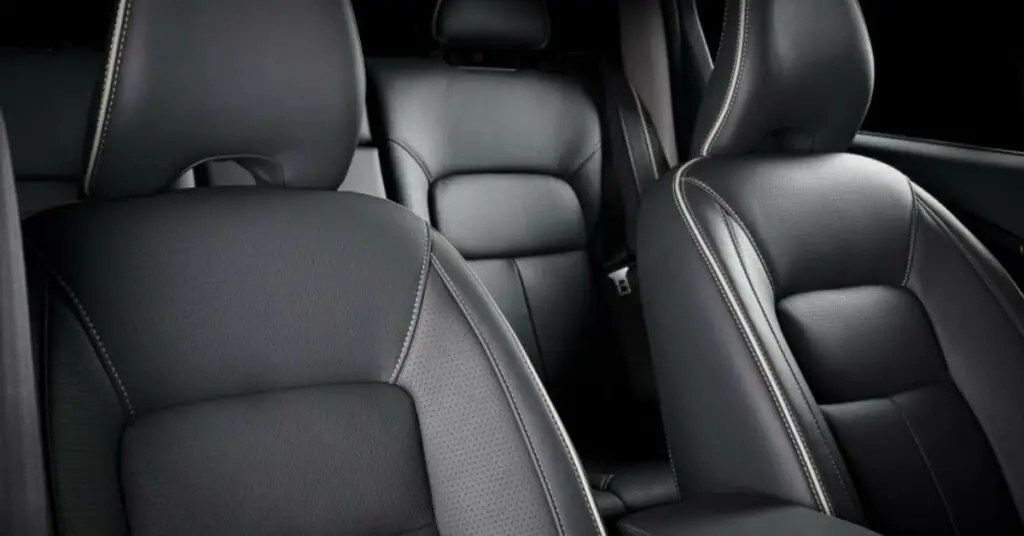
So you’re in the market for a new car, and you stumble upon something called “Syntex seating material.” This isn’t just upholstery; it’s the future of car comfort. But what is it? How does it compare to the tried-and-true leather seats you’ve been loyal to? In this comprehensive guide, we’re peeling back the layers of Syntex to reveal what makes it a game-changer in the automotive world.
Why This Topic Matters in Car Seating
- It’s the next-gen material.
- It’s challenging the leather status quo.
- It’s got car buyers buzzing.
What is Syntex Seating Material?
Syntex, not to be confused with syntax (that’s for the grammar nerds), is a synthetic fabric taking the car industry by storm. Think of it as the Tesla of fabrics—innovative, modern, and potentially eco-friendlier.
The Makeup
Made from high-density polyurethane foam and polyester fibers, Syntex is engineered for the long haul. These materials are woven tightly to create a fabric that’s not just strong but also resistant to wear and tear.
The Application in Cars
Syntex isn’t just for office chairs or recliners. Oh no, it’s making a statement in cars, from budget-friendly Kias to premium BMWs. It’s especially gaining traction in vehicles meant for heavy use—think family SUVs and commercial fleets.
Why Car Manufacturers Are Opting for Syntex
- Durability: Built to last, unlike your average boy band.
- Easy to Clean: Spill coffee? No biggie. A damp cloth’s all you need.
- Cost-Effective: Less pricey than leather, but doesn’t skimp on quality.
- Comfort: Engineered to offer support and cushioning, because your back deserves it.
- Versatility: Comes in a range of colors and styles. Match your car’s vibe!
Syntex vs. Leather: The Showdown in Car Seating
The battle for the best car seat material is like a drag race, and it’s leather vs. Syntex on the track. Both have their die-hard fans, but how do they actually stack up? Let’s break it down.
Durability
Leather is known for its durability, but Syntex is no slouch either. In fact, it’s engineered to withstand heavy use, which makes it a star player in family cars and commercial vehicles.
Maintenance
Leather can be a diva when it comes to cleaning and conditioning. Syntex, on the other hand, is low-maintenance. A simple wipe down is usually all it takes to keep it looking fresh.
Cost
Leather often comes with a premium price tag. Syntex offers a more wallet-friendly alternative without compromising too much on quality and appearance.
Comfort and Feel
Leather has a luxurious feel that’s hard to beat. However, Syntex is designed for comfort, providing ample support and cushioning. It’s like the memory foam mattress of car seats.
Pros and Cons of Syntex vs. Leather
| Aspect | Syntex Pros | Syntex Cons | Leather Pros | Leather Cons |
|---|---|---|---|---|
| Durability | High resistance to wear and tear | May lack the “luxury” feel of real leather | Ages well, durable | Can crack or fade without proper maintenance |
| Maintenance | Easy to clean, low maintenance | Can feel sticky in hot weather | Easy to clean with right products | Requires special cleaning products |
| Cost | Generally less expensive | Quality may vary between brands | Premium feel | More expensive |
| Comfort | Designed for support and cushioning | Some find it less breathable | Known for luxury and comfort | May require break-in period |
So, who wins the drag race? Well, it’s not a clear-cut victory. Both materials have their merits, and the best choice depends on your priorities—whether it’s durability, maintenance, cost, or comfort.
Syntex in Cars: A Case Study of Kia Telluride
Let’s get specific, and what better way to do that than to zoom in on a real-world example? Enter the Kia Telluride, an SUV that offers Syntex as an option for its seats. Why does this matter? Because the Telluride isn’t just any SUV; it’s a fan favorite and a critical darling.
Customer Experiences
Forum discussions and customer reviews reveal some mixed yet intriguing feedback on Syntex seating in the Telluride. For some, the material proves to be a durable and easy-to-clean alternative to leather, especially when kids are in the equation. Others mention that the material can make your legs sweat more than leather, a point to consider if you’re planning on long drives.
Key Points from Telluride Owners About Syntex
- Stain Resistance: Easy to clean, especially from spills or stains from blue jeans.
- Durability: Some users reported minor issues like tears, especially when pets are involved.
- Comfort: Generally comfortable, but some find it less breathable than leather.
- Cost: More affordable than leather options, a plus for budget-conscious buyers.
- Real-World Use: Practical for families, but consider your climate and driving conditions.
Expert Opinions
Experts like those at Consumer Reports and Car & Driver also give a nod to the Syntex option in the Telluride. It’s hailed for being a quality synthetic fabric that holds up well over time, even in comparison to some leather options.
Cleaning and Maintenance of Syntex
You’ve got the car, you’ve got the Syntex seats, and now you’ve got… a coffee spill. No worries! One of the standout features of Syntex is its ease of maintenance. But how do you keep it looking as good as new?
Basic Cleaning
A damp cloth or sponge is usually all you need for basic cleaning. Just wipe down the Syntex material and you’re good to go. It’s that simple, folks.
Dealing with Stains
Got something a little more stubborn? For tougher stains, you might need to bring out the mild soap. But before you go to town on that stain, test it in an inconspicuous area to make sure you’re not doing more harm than good.
Special Considerations
If you’ve got pets (looking at you, dog owners), it’s essential to consider claw marks. While Syntex is durable, it’s not invincible. For extra protection, consider seat covers or keep pets in a designated area of the car.
Cleaning Tips for Syntex Seating Material
- Basic Wipe-Down: A damp cloth can tackle most messes.
- Stubborn Stains: Mild soap and water, but test an unseen area first.
- Pet Precautions: Consider seat covers for added protection against claws.
- Vacuum Regularly: To remove crumbs and dust that can grind into the material.
- Avoid Harsh Chemicals: Stick to mild cleaners to maintain the integrity of the Syntex.
Conclusion: Is Syntex the Right Choice for Your Car Seats?
We’ve dived into the nitty-gritty of Syntex, pitted it against leather, looked at real-world applications in the Kia Telluride, and even spilled some virtual coffee to talk about cleaning. So, what’s the final verdict?
It’s All About You
When it comes down to it, the best material for your car seats is a personal choice. If you’re after something that’s durable, easy to maintain, and budget-friendly, Syntex is a strong contender. But if the luxury and breathability of leather are non-negotiables for you, then you already have your answer.
Final Considerations for Choosing Syntex
| Consideration | Why It Matters |
|---|---|
| Durability | Ideal for families and high-use scenarios. |
| Maintenance | Low-maintenance could mean more time enjoying the drive. |
| Cost | Budget-friendly without sacrificing too much on quality. |
| Real-world Feedback | Always check customer and expert reviews for the specific car model you’re eyeing. |
Ready to Make the Call?
Choosing between Syntex and leather is like picking your favorite ice cream flavor. Both have their merits, and both will make many people happy—it just depends on your taste (or in this case, your butt and back).
So, there you have it. Syntex could be the future of car seating, but whether it’s the future for you is a road you’ll have to travel yourself.

As a seasoned mechanic and proud owner of three successful car workshops, I’ve dedicated my life to helping people just like you overcome their everyday automotive challenges. I created this website as a labor of love, with a simple mission: to make car maintenance and repairs more accessible and approachable for the “average joe.”
